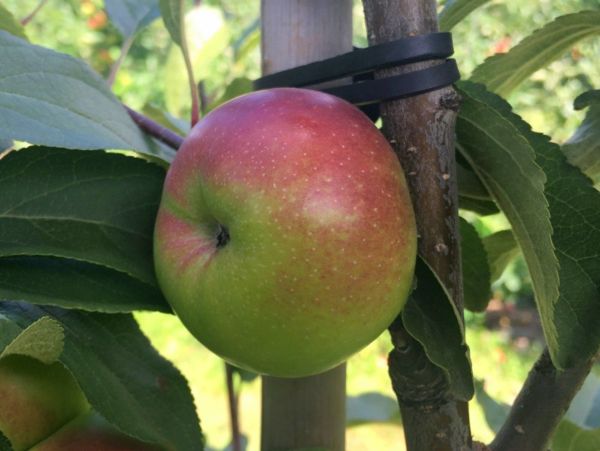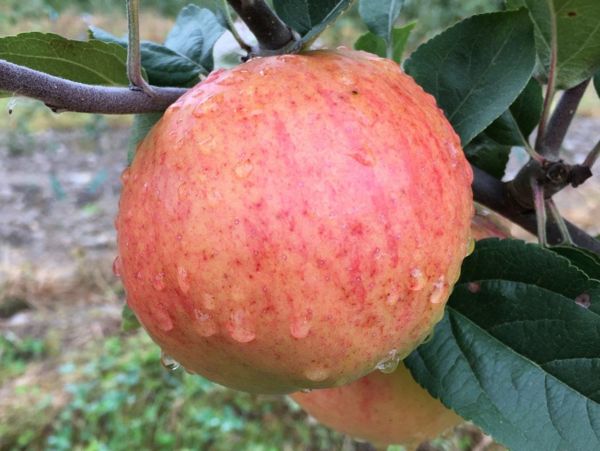An attractive, highly disease-resistant apple, ideal for organic growers.
Lady Apple Scionwood (Spring 2024)
A small, highly fragrant, antique dessert apple from France. Also known as Api, Pomme d'Api, Rose Apple, Christmas Apple, Longbois.
A small tree that bears heavily, Lady is recommended for the home garden. The tree is strongly biennial, but it will crop heavily in its productive years. It has a very upright habit–limb spreading is recommended–and it is susceptible to fireblight and scab, but resistant to cedar-apple rust.
Growing in clusters of four to seven apples, Lady is small (about one inch diameter), flattish, and highly fragrant. It has a long-standing traditional association with Christmas, and a bowl or wreath of these fragrant yellow and scarlet jewels does seem like the perfect seasonal centerpiece. The skin is thin and delicate, and the flesh is fine grained and white. Bright and astringent when harvested at the end of October, the flavor mellows by Christmas to a nutty sweetness. Because it is a small and flavorful apple, it was popular during the Renaissance when ladies would keep one tucked away in their pockets to use as a breath freshener. It will store well (not in your pocket) for about two months.
This apple was grown in the garden of Louis XIII in Orleans 1628. It most likely originated as seedling in the Forest of Api in Bretagne, west France. In France it is called Api, and the Victorian author Robert Hogg reports that it was called une pomme des damoiselles et de bonne compagnie, an apple for ladies and good company.
Volume Pricing
| Quantity | Lady Apple Scion |
|---|---|
| 1 | $12.00 |
| 2-5 | $7.00 |
| 6-10 | $6.00 |
| 11-99 | $5.00 |
| 100+ | $4.00 |
The Fruit
Fruit Type
Category: Apple
Subcategory:
Heirloom, Cold-Hardy, Hot-Climate
Fruit Uses & Storage
Uses: fresh eating, cider
Storage duration: one to three months (approximate, depending on storage conditions)
Fruit Appearance
Skin color: red
Flesh color: white
Fruit Origins
Parentage: unknown
Origin: France
Introduced in: 1500s
Introduced by:
The Environment
Calendar & Geography
USDA zones: 4 - 8
Chill hours: Not yet determined
Ripening date: Nov 03 (approximate, in New York State) + 49 days after McIntosh
Diseases & Pests
glossary
Apple Scab: Susceptible
Cedar-Apple Rust: Resistant
Fireblight: Susceptible
Pollination
Pollination Factors
glossary
Bloom group: 3
Is it self-fertile? N
Is it fertile? Y
Ploidy: Diploid
Pollination Partners
This table shows the first few results from a full search for pollenizers of Lady Apple. Please see our Pollenizer Search to run other queries and read how the application uses various factors. Also read more about fruit tree pollination.
| Tree | Currently in Stock |
|---|---|
| Florina Apple | 0 |
| Porter's Perfection Apple | 0 |
| Spitzenburg Esopus Apple | 0 |
| Rubinette Apple | 0 |
| Virginia Crab Apple | 0 |
| Bramtot Apple | 0 |
| Binet Rouge Apple | 0 |
| Mother Apple | 0 |
| Repinaldo Do Liebana Apple | 0 |
| Melrose Apple | 0 |
| Muscadet De Dieppe Apple | 0 |
See all pollination matches for Lady Apple
Featured Products
A few things we're loving right now...
A full-flavored, freestone white peach.
A traditional semisharp cider apple from Spain.
A widely-grown, large, yellow-fleshed nectarine.


















